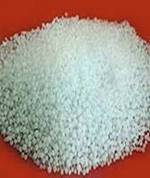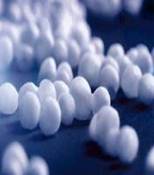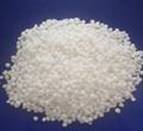CLASSIFICATION OF FERTILISERS
Fertilisers

1. Straight fertilizers: Straight fertilizers are those which supply only one primary plant nutrient, namely nitrogen or phosphorus or potassium.
eg. Urea, ammonium sulphate, potassium chloride and potassium sulphate.
2. Complex fertilizers: Complex fertilizers contain two or three primary plant nutrients of which two primary nutrients are in chemical combination. These fertilisers are usually produced in granular form.
eg. Diammonium phosphate, nitrophosphates and ammonium phosphate.
3. Mixed fertilizers: are physical mixtures of straight fertilisers. They contain two or three primary plant nutrients. Mixed fertilisers are made by thoroughly mixing the ingredients either mechanically or manually.
Fertilisers can also be classified based on physical form:
- Solid
- Liquid fertilizers
Fertilizer

Solid fertilizers are in several forms viz.
- Powder (single superphosphate),
- Crystals (ammonium sulphate),
- Prills (urea, diammonium phosphate, superphosphate),
- Granules (Holland granules),
- Supergranules (urea supergranules) and
- Briquettes (urea briquettes).



Urea prills Granulated urea Ammonium sulphate
Liquid fertilizers:
- Liquid form fertilizers are applied with irrigation water or for direct application.
- Ease of handling, less labour requirement and possibility of mixing with herbicides have made the liquid fertilisers more acceptable to farmers.
Fertilizer

Nitrogenous fertilizer
![]()
|
Ammoniacal
|
Nitrate |
Ammoniacal and |
Amide fertilizer |
|
|
|
|
A. Nitrogenous fertilizers
- Nitrogenous fertilizers take the foremost place among fertilizers since the deficiency of nitrogen in the soil is the foremost and crops respond to nitrogen better than to other nutrients.
- More than 80 per cent of the fertilizers used in this country are made up of nitrogenous fertilizers, particularly urea.
- It is extremely efficient in increasing the production of crops and the possibilities of its economic production are unlimited.
The nitrogenous fertilizers can be further classified as given below:
1. Ammoniacal fertilizers
- Ammoniacal fertilizers contain the nutrient nitrogen in the form of ammonium or ammonia.
- Ammoniacal fertilizers are readily soluble in water and therefore readily available to crops.
- Except rice, all crops absorb nitrogen in nitrate form. These fertilizers are resistant to leaching loss, as the ammonium ions get readily absorbed on the colloidal complex of the soil.
a) Ammonium sulphate [(NH4)2 S04]
- It is a white salt completely soluble in water containing 20.6 .per cent of nitrogen and 24.0 per cent of sulphur.
- It is used advantageously in rice and jute cultivation.
- It is easy to handle and it stores well under dry conditions. But during rainy season, it sometimes forms lumps.
- It can be applied before sowing, at the time of sowing or as a top-dressing to the growing crop.
b) Ammonium chloride (NH4Cl)
- It is a white salt contains 26.0 per cent of nitrogen.
- It is usually not recommended for tomato, tobacco and such other crops as may be injured by chlorine.

c) Anhydrous ammonia (NH4)
- It is a colourless and pungent gas containing 82.0 per cent nitrogen.
- It is the cheapest and can be applied directly to soil by injection using blade type applicator having tubes.
- It becomes liquid (anhydrous ammonia) under suitable conditions of temperature and pressure.
2. Nitrate Fertilizers
- Nitrate fertilizers contain the nitrogen in the form of NO3
- These ions are easily lost by leaching because of the greater mobility of nitrate ions in the soil.
- Continuous use of these fertilizers may reduce the soil acidity as these nitrogenous fertilizers are basic in their residual effect on soils.
a) Sodium nitrate (NaNO3)
- Sodium nitrate is a white salt containing about 15.6 per cent of nitrogen.
- It is completely soluble in water and readily available for the use of plants as such, without any chemical change in the soil.
- It is easily lost by leaching and denitrification.
- When large quantities of sodium nitrate are added year after year, the nitrate ions are absorbed by crops and sodium ions accumulate and affect the structure of the soil. Sodium nitrate is also known as chile salt peter or chilean nitrate.
- Sodium nitrate is particularly useful for acidic soils
b) Calcium nitrate [Ca (NO3)2]
- It is a white crystalline hygroscopic solid soluble in water containing 15.5 per cent nitrogen and 19.5 per cent calcium.
- The calcium is useful for maintaining a desirable soil pH.

Calcium nitrate
c) Potassium nitrate (KN03)
- The purified salt contains 13.0 per cent nitrogen and 36.4 per cent potassium.
- The nitrogen of the potassium nitrate has the same properties and value as that of the sodium nitrate.
3. Ammoniacal and nitrate fertilizers
These fertilizers contain nitrogen in both ammonium and nitrate forms. The nitrates are useful for rapid utilization by crops and the ammonical is gradually available.
a) Ammonium nitrate (NH4N03)
- It is white, water soluble and hygroscopic crystalline salt containing 35 per cent nitrogen half as nitrate nitrogen and half in the ammonium form.
- In the ammonium form, it cannot be easily leached from the soil.
- This fertilizer is quick-acting, but highly hygroscopic and not fit for storage.
- It has an acidulating effect on the soil.
- It is dangerous in pure form because of explosion hazard.
b) Calcium ammonium nitrate (CAN)
- Calcium ammonium nitrate is a fine free-flowing, light brown or grey granular fertilizer, containing 26 per cent of nitrogen.
- It is almost neutral and can be safely applied even to acid soils.
- Half of its total nitrogen is in the ammoniacal form and half is in nitrate form.
- It is made harmless by adding lime.

Calcium ammonium nitrate
c) Ammonium sulphate nitrate [(NH4)2S04 NH4NO3]
- It contains 26 per cent nitrogen, three fourths of it in the ammoniacal form and the rest (6.5 per cent) as nitrate nitrogen.
- In addition to nitrogen it contains 12.1percent sulphur.
- It is a mixture of ammonium nitrate and ammonium sulphate.
- It is available in a white crystalline form or as dirty-white granules.
- It is readily soluble in water and is very quick-acting.
- Its keeping quality is good and it is useful for all crops.
- Its acid effect on the soils is only one-half of that of ammonium sulphate.
- It can be applied before sowing, at sowing time or as a top-dressing.
4. Amide fertilizers
- Amide fertilizers are readily soluble in water and easily decomposable in the soil.
- The amide form of nitrogen is easily changed to ammoniacal and then to nitrate form in the soil.
a) Urea [CO (NH2)2]
- It is the most concentrated solid nitrogenous fertilizer, containing 46 per cent nitrogen.
- It is a white crystalline substance readily soluble in water.
- It absorbs moisture from the atmosphere and has to be kept in moisture proof containers. It is readily converted to ammoniacal and nitrate forms in the soil.
- The nitrogen in urea is readily fixed in the soil in an ammoniacal form and is not lost in drainage.
- Urea sprays are readily absorbed by plants.
- It may be applied at sowing or as, a top-dressing.
- It is suitable for most crops and can be applied to all soils.
b) Calcium cyanamide (CaCN2)
- Calcium cyanamide or nitrolime contains 20.6 per cent of nitrogen.
- It is a greyish white powdery material that decomposed in moist soil giving rise to ammonia.
B. Phosphatic fertilizers
- Phosphatic fertilizers are chemical substances that contain the nutrient phosphorus in absorbable form (Phosphate anions) or that yield after conversion in the soil.
Super phosphate [Ca (H2PO4)2)
- This is the most important phosphatic fertilizer in use.
- It contains 16 Per cent P2O5 in available form.
- It is a grey ash like powder with good keeping or storage qualities.
- Phosphatic fertilizer hardly moves in the soil and hence they are placed in the, root zone.
Triple super phosphate:
- The concentrated super phosphate is called as Triple super phosphate and it contains 46 per cent P2O5.
- This fertilizer is suitable for all crops and all soils.
- In acid soils, it should be used in conjunction with organic manure.
- It can be applied before or at sowing or transplanting.
C. Potassic fertilizers
- Potassic fertilizers are chemical substances containing potassium in absorbed form (K+).
- There are two potassium fertilizers viz., muriate of potash (KCI) and sulphate of potash (K2S04).
- They are water soluble and so are readily available to plants.
a) Potassium chloride (KCI)
- Potassium chloride or muriate of potash is a white or red, crystal containing 60.0 per cent K2O.
- It is completely soluble in water and therefore readily available to the crops.
- It is not lost from the soil, as it is absorbed on the colloidal surfaces.
- It can be applied at sowing or before or after sowing.
- The chlorine content is about 47.0 per cent.
- Its chlorine content is objectionable to some crops like tobacco, potato, etc where quality is the consideration.
b) Potassium sulphate (K2S04)
- Potassium sulphate or sulphate of potash is a white salt and contains 48 per cent K2O.
- It is soluble in water and therefore readily available to the crop.
- It does not produce any acidity or alkalinity in the soil.
- It is prefered for fertilization of crops like tobacco, potato etc., where quality is of prime importance.
- It is costly because it is made by treating potassium chloride with magnesium sulphate. .
E. Secondary major-nutrient fertilizers
a. Magnesium fertilizers
These are chemical substances containing the nutrient magnesium in the form of magnesium cations (Mg2+).
Magnesium Sulphate (MgSO4)
The utilization rate of magnesium fertilizers decreases w,ith incr,easing potassium supplies.
b. Calcium fertilizers
- These are the chemical substances containing the nutrient calcium in absorbable calcium cations ('Ca2+) form.
-
The raw material of calcium fertilizers is lime found in nature.
Calcium Chloride (CaCl2 6H2O)
- It contains at least 15 per cent calcium.
- It is highly water soluble and can, therefore, be dissolved for application as a foliar nutrient.
c. Sulphate Fertilizers
- These are chemical substances containing the nutrient sulphur in the form of absorbable sulphate anions (SO42-).
- The sulphur requirements of plants are about two third of their phosphorus requirements.
- Substantial sulphur supplies occur as minor constituents of various N, P and K fertilizers.
- Fertilization with sulphur becomes necessary with increasing removal from the soil with rising agricultural production especially in plants with high sulphur requirements. e.g. mustard
D. Micronutrient Fertilizers
- The importance of fertilization of crops with micro-nutrients is increasing mainly because of greater removal from the soil, intensive liming of soil, intensive drainage of soil, higher use of nitrogenous, phosphatic and potassic fertilizers etc.
- There are seven essential micronutrients required by plants.
These are iron, manganese, zinc, copper, chlorine, boron and molybdenum.
a. lron fertilizers
- These are generally water soluble substances, predominantly sprayed as foliar nutrients on the crops.
- Plants absorb iron in the form of Fe2+.
Commonly used iron fertilizers are as follows.
|
Ferrous sulphate |
It is a water soluble fertilizer containing 20 % Fe |
|
Fe – Chelates |
Suitable for application as foliar nutrients |
b. Manganese fertilizers
The manganese (Mn) fertilizers are as follows:
|
Manganous Sulphate |
It is the well known water soluble Mn fertilizer. |
|
Mn – chelates (Mn – DTA) |
It contains 13 % Mn. |
c. Zinc fertilizers
Zinc (Zn) fertilizers play an important role in Zn deficient areas.
|
Zinc sulphate |
It is water soluble whitish salt containing 23 % Zn. |
|
Zinc-oxide(ZnO) |
It contains 70 % Zn. |
d. Copper Fertilizers
Copper fertilizers have been used to correct copper (Cu), deficiencies.
Copper sulphate (CuSO4 5H2O) – 25 % Cu
Copper sulphate (CuSO4 H2O) – 36 % Cu
e. Boron Fertilizers
| Borax (Na2B4O 10H2O) |
It contains 11 % B |
|
Boric acid (H3BO3) |
It contains 18 % B |
f. Molybdenum Fertilizers
|
Sodium molybdate (Na2MoO42H2O) |
It contains 40 % Mo |
|
Ammonium molybdate |
It contains 54 % Mo |
-
These are water soluble salts which contain Mo
-
They are suitable for soil application and foliar application as wel
any liquid and solid calcium fertilizer,
CHEMICAL
FERTILIZERS
FORMULATIONS
ENCYCLOPEDİA
is enough.
This encyclopedia has many formulas about NPK fertilizers,NP fertilizers,liquid poliar fertilizers, powder fertilizers, granulas fertilizers, micro nutrients fertilizers,macro nutrients fertilizers,chelated fertilizers etc.
All chemical fertilizers in the encyclopedia are producible easily.You need no help and no technıcal support. The encyclopedia is enough to produce chemical fertilizers itself.
CHEMICAL
FERTILIZERS
FORMULATIONS
ENCYCLOPEDIA
is written clear and understandable.
RELATED TAGS: What is calcium nitrate fertilizer,how to make liquid calciumfertilizers, making calcium fertilizer, properties of calcium fertilizers, effects ofcalcium fertilizers, benefits of calcium fertilizer, advantages of calcium chloride fertilizers, formulations of calcium chloride fertilizer,compounds of calciumfertilizers, powder calcium fertilizers making, properties of solid calciumfertilizer, calcium fertilizer composition,using liquid micronutrients fertilizers, solid microelement fertilizers,using micronutrient fertilizers,plants to calcium,calcium nitrate fertilizers in agricultural, how to make microelement fertilizers,making powder micronutrient fertilizers,micro elements fertilizers,properties of calcium sulphate fertilizers, liquid calcium fertilizers, to make calcium nitrate fertilizers, preparation of liquid calciumfertilizers,production of copper fertilizers, calcium fertilizer production,productions,types of chemical fertilizers,fertilizer types,zinc sulphaTE fertilizers,micronutrient fertilizers, combi fertilizers, manufacturing fertilizers,how to use chemical fertilizers,foliar fertilizers,drip fertilizers, npk fertilizers, balance fertilizers, to make balance fertilizers,powder fertilizers manufacturing,granules fertilizer making,compositions of fertilizers, formulations of fertilizers, how to programme of fertilizers, using fertilizers.


E - BOOKS AND HARD BOOKS

HOW TO BUY
AGRICULTURE ENCYCLOPEDIAS AND VIDEOS

|
|

|
|

|
|
